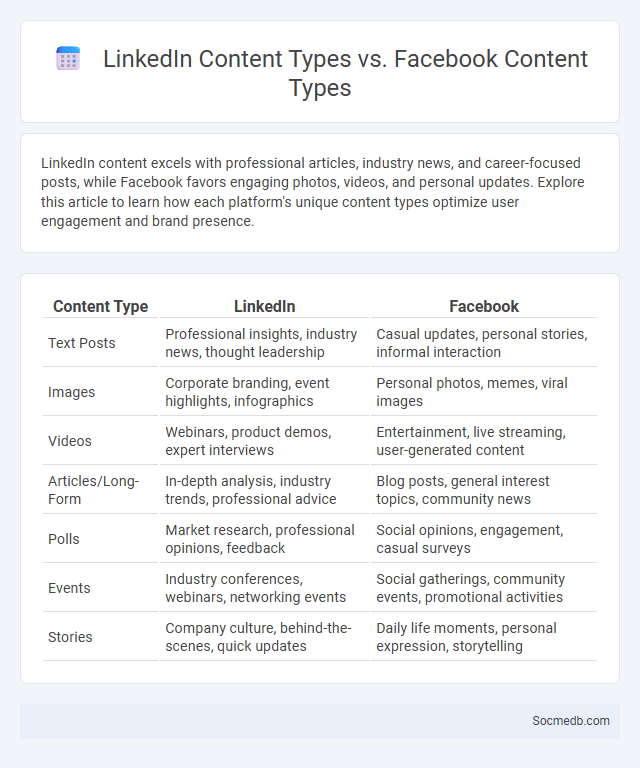
Photo illustration: LinkedIn Content Types vs Facebook Content Types
LinkedIn content excels with professional articles, industry news, and career-focused posts, while Facebook favors engaging photos, videos, and personal updates. Explore this article to learn how each platform's unique content types optimize user engagement and brand presence.
Table of Comparison
| Content Type | ||
|---|---|---|
| Text Posts | Professional insights, industry news, thought leadership | Casual updates, personal stories, informal interaction |
| Images | Corporate branding, event highlights, infographics | Personal photos, memes, viral images |
| Videos | Webinars, product demos, expert interviews | Entertainment, live streaming, user-generated content |
| Articles/Long-Form | In-depth analysis, industry trends, professional advice | Blog posts, general interest topics, community news |
| Polls | Market research, professional opinions, feedback | Social opinions, engagement, casual surveys |
| Events | Industry conferences, webinars, networking events | Social gatherings, community events, promotional activities |
| Stories | Company culture, behind-the-scenes, quick updates | Daily life moments, personal expression, storytelling |
Overview: LinkedIn vs Facebook Content Ecosystems
LinkedIn's content ecosystem centers on professional networking, featuring industry news, expert insights, and career development resources tailored to business audiences. Facebook's platform prioritizes personal connections and broad social interactions, supporting diverse content types such as videos, photos, and group discussions that engage a wide demographic. Understanding the distinct purposes and content forms of LinkedIn and Facebook helps optimize your social media strategy for targeted reach and engagement.
Understanding LinkedIn Content Types
Understanding LinkedIn content types is essential for maximizing your professional reach and engagement on the platform. You can leverage diverse formats such as articles, native videos, images, polls, and carousel posts to showcase expertise and connect with your network effectively. Tailoring your content to LinkedIn's algorithm by mixing educational, inspirational, and industry-specific posts enhances visibility and drives meaningful interactions.
Exploring Facebook Content Formats
Facebook offers a variety of content formats including videos, photos, stories, live broadcasts, and text posts to engage diverse audiences. Utilizing Facebook's native video player optimizes reach and interaction, while Stories provide a temporary, immersive experience perfect for timely updates. To maximize Your social media impact, experiment with carousel ads and interactive polls that encourage user participation and foster brand loyalty.
Comparing Engagement Patterns Across Platforms
Engagement patterns vary significantly across social media platforms, with Instagram emphasizing visual content interactions, Twitter fostering real-time conversations, and LinkedIn targeting professional networking and article sharing. Your content strategy should adapt to these differences by prioritizing visuals on Instagram, concise updates on Twitter, and in-depth posts on LinkedIn to maximize user interaction. Understanding these platform-specific behaviors enhances audience reach and boosts overall engagement metrics.
How Feed Ranking Algorithms Work on LinkedIn
LinkedIn's feed ranking algorithms prioritize content based on relevance, user engagement, and professional connections to deliver personalized updates. The system analyzes factors such as post interactions, profile data, and network activity to determine the likelihood of interest, boosting posts that generate meaningful conversations. Machine learning models continuously refine the algorithm to enhance user experience by promoting timely and contextually appropriate content within professional networks.
Facebook’s Feed Ranking: Key Factors
Facebook's Feed Ranking prioritizes content based on factors such as user engagement, relevance, and timeliness to ensure Your feed shows the most meaningful posts. The algorithm analyzes actions like likes, comments, shares, and the type of content to tailor the experience to individual preferences. Prioritizing posts from friends, family, and highly interactive pages boosts visibility and maintains user satisfaction on the platform.
Impact of Content Types on Visibility
Visual content such as images and videos significantly boosts your social media visibility by capturing attention and encouraging shares. Informative posts like how-tos and infographics increase engagement rates by providing value that algorithms favor. User-generated content and interactive formats like polls enhance reach by fostering community participation and trust.
Content Strategy: Platform-Specific Best Practices
Developing a successful content strategy requires understanding platform-specific best practices such as Instagram's emphasis on high-quality visuals and Stories for engagement, Twitter's focus on concise, timely updates, and LinkedIn's preference for professional, long-form content. Tailoring content to fit each platform's unique audience behavior and algorithm boosts reach and interaction. Consistently analyzing performance metrics on each network refines strategy and maximizes effectiveness.
Measuring Performance: LinkedIn vs Facebook
Measuring performance on LinkedIn versus Facebook requires analyzing key metrics such as engagement rate, reach, and conversion rates specific to each platform's audience. LinkedIn excels in B2B lead generation and professional networking, making metrics like connection requests, InMail responses, and content shares critical for assessing ROI. You should tailor your performance measurement tools to monitor audience demographics, interaction types, and campaign goals unique to LinkedIn and Facebook.
Future Trends in Social Feed Algorithms
Social feed algorithms are increasingly leveraging artificial intelligence and machine learning to deliver highly personalized content tailored to Your preferences and behavior patterns. Predictive analytics will enable platforms to anticipate Your interests, enhancing engagement and content relevance in real time. Emerging trends include the integration of augmented reality and voice recognition technologies, transforming the way social media algorithms curate interactive and immersive user experiences.
 socmedb.com
socmedb.com